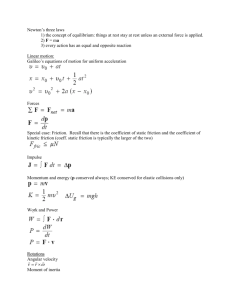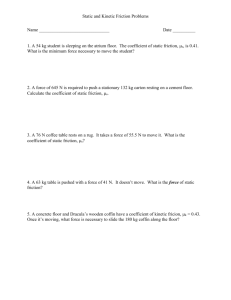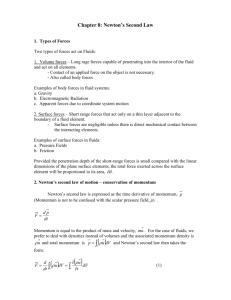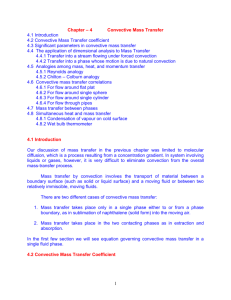Partial Differential Equations in Two or More Dimensions
advertisement
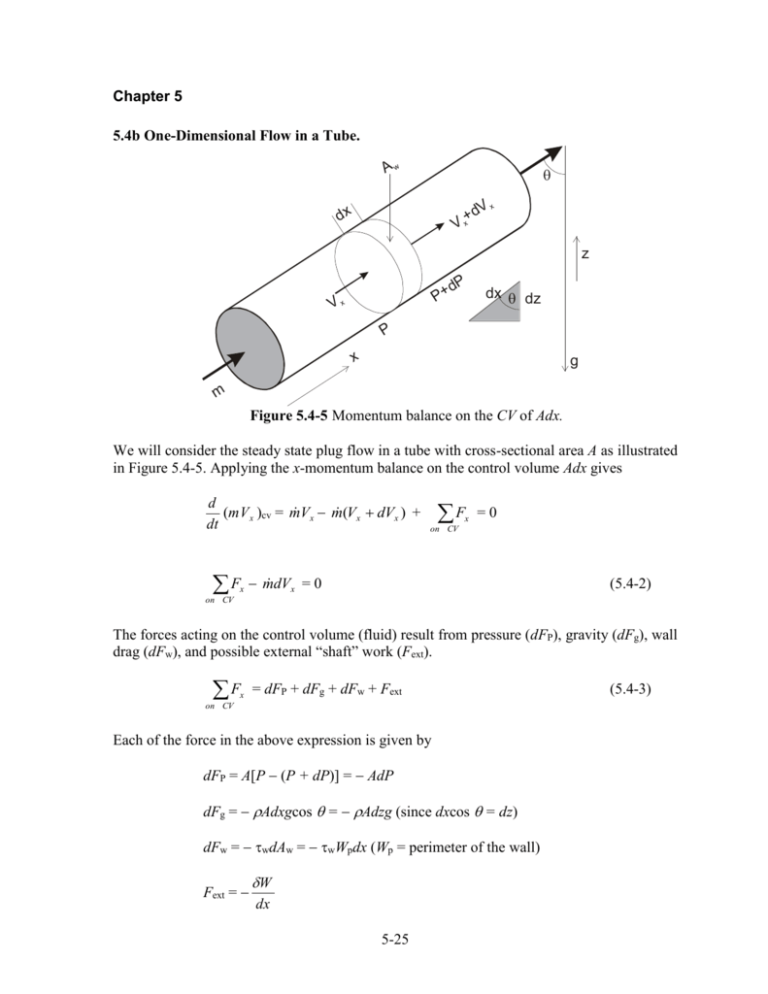
Chapter 5 5.4b One-Dimensional Flow in a Tube. Aw dx V dV x + x z P+ Vx dP dx dz P x g m Figure 5.4-5 Momentum balance on the CV of Adx. We will consider the steady state plug flow in a tube with cross-sectional area A as illustrated in Figure 5.4-5. Applying the x-momentum balance on the control volume Adx gives d (m V x )cv = m Vx m (Vx dVx ) + dt F x F x =0 on CV m dVx = 0 (5.4-2) on CV The forces acting on the control volume (fluid) result from pressure (dFP), gravity (dFg), wall drag (dFw), and possible external “shaft” work (Fext). F x = dFP + dFg + dFw + Fext on CV Each of the force in the above expression is given by dFP = A[P (P + dP)] = AdP dFg = Adxgcos = Adzg (since dxcos = dz) dFw = wdAw = wWpdx (Wp = perimeter of the wall) Fext = W dx 5-25 (5.4-3) In these expressions, w is the stress exerted by the fluid on the wall and W is the shaft work performed by the fluid. Substituting the expressions for the forces from Eq. (5.4-3) into the momentum balance equation (5.4-3) gives AdP Adzg wWpdx W m dVx = 0 dx Dividing the equation by ( A), we obtain dP + gdz + wW p VA W dx + + dV = 0 Adx A A In this equation V = Vx. Let w = W = work done per unit mass of fluid, the equation Adx becomes dP + gdz + wW p dx + w + VdV = 0 A Integrating this expression from the inlet to the outlet gives Po dP Pi where w = + g(zo zi) + L 0 wW p 1 dx + w + (oVo2 iVi2) = 0 2 A (5.4-4) w , and = kinetic energy correction factor, = 2 for laminar flow, = 1 for turbulent flow. Comparing equation (5.4-4) with the energy equation (5.3-9) Po dP Pi + g(zo zi) + 1 (oVo2 iVi2) + ef + w = 0 2 (5.3-9) shows that they are identical, provided ef = L 0 wW p dx A For steady flow in a uniform conduit ef = wW p L w 4 L A , where Dh = 4 = Dh Wp A In this expression Dh is called the hydraulic diameter for a conduit of any cross-sectional shape. For a circular tube Dh is the same as the tube diameter D 5-26 D 2 A =4 =D 4D Wp Dh = 4 For this special case of one-dimensional fully developed flow in a straight uniform pipe, the energy and momentum equations provide the same results for the relationship between temperature, pressure, density, velocity, and dissipated energy (ef) across the system. From the energy balance, ef represents the lost energy associated with irreversible effects. From the momentum balance, ef represents the work required or friction loss to overcome the frictional force at the wall. In general, the momentum balance gives additional information relative to the forces exerted on and/or by the fluid in the system through the boundaries. This information cannot be obtained by the energy equation. 5.4c Definition of the Loss Coefficient and the Friction Factor The energy equation can be made dimensionless by dividing it by any term within the equation. Po dP Pi + g(zo zi) + 1 (oVo2 iVi2) + ef + w = 0 2 (5.3-9) If the dividing term is the kinetic energy per unit mass of fluid, we obtain the dimensionless loss coefficient, Kf Kf = ef V2 /2 A loss coefficient can be defined for any element that causes resistance to flow such as a length of pipe, a valve, a pipe fitting, a contraction, or an expansion. The total friction loss is then calculated from the sum of the losses in each element. ef = K fi i 1 2 Vi 2 The pipe wall stress (w) is the flux of momentum from the fluid to the tube wall. Therefore it can be made dimensionless by dividing by the flux of momentum V2 carried by the fluid along the conduct. However a factor of ½ is chosen for the flux of momentum so that it represents the kinetic energy per unit volume (½V2). The Fanning friction factor f is defined as f = w V 2 / 2 Mechanical and civil engineers usually use the definition of the Darcy friction factor fD given by 5-27 fD = 4 w V 2 / 2 = 4f The advantage of this definition is that the lost energy will have a form that shows a direct dependence on the kinetic energy per unit mass. Since w = 1 fDV2 8 The lost energy in terms of the Darcy friction factor fD is given by ef = wW p L w 4 L 1 L = fDV2 = Dh 2 A Dh Thus, it is important to know which definition is implied when data for friction factors are used. The Fanning friction factor can be related to the loss coefficient Kf = ef 2 V /2 = 2 w V2 4L 2 fV 2 = 2 2 Dh V 4L 4 fL = Dh Dh Example 5.4-32 ---------------------------------------------------------------------------------Consider the flow in a sudden expansion from a small conduit to a larger one. The conditions upstream of the expansion (point 1) are known, as well as the areas A1 and A2. Find the velocity and pressure downstream of the expansion (V2 and P2) and the loss coefficient, Kf. A1 V1 P1 A2 V2 P2 x P1a Figure 5.4-6 Flow through a sudden expansion. Solution -----------------------------------------------------------------------------------------Applying the mass balance to the fluid in the shaded area give A1 A2 The downstream pressure (P2) can be obtained from the energy equation V2 = V1 2 Darby, R., Chemical Engineering Fluid Mechanics, Marcel Dekker, 2001, p. 124 5-28 P2 P1 + 1 (V22 V12) + ef = 0 2 Since the above equation contains two unknowns, P2 and ef. We need another equation, the steady-state momentum balance F x (V2 V1) = 0 m on CV The forces acting on the control volume are substituted into the equation to obtain P1A1 + P1a(A2 A1) P2A2 + Fwall = A1V1(V2 V1) In this equation P1a is the pressure force from the solid surface on the left-hand boundary of the system, and Fwall is the drag force of the wall on the fluid at the horizontal boundary of the system. Since the fluid pressure cannot change suddenly, P1a P1. Neglect Fwall because the horizontal boundary of the system is relatively small, we have A (P1 P2)A2 = A1V12 1 1 A2 From the energy equation ef = P1 P2 2 1 2 A1 A1 2 A1 1 2 2 + (V1 V2 ) = V1 1 + V1 1 A2 2 A2 A2 2 A A 1 A ef = V12 2 1 2 1 1 1 A2 2 A2 A2 2 2 2 1 = V12 1 A1 2 A2 2 A The loss coefficient for the flow through a sudden expansion is defined as Kf = 1 1 , A2 therefore ef = 1 KfV12 2 The experimental value of the loss coefficient for a sharp 90o contraction is Kf = 0.5(1 2) D where = 1 . For most systems, the loss coefficient cannot be determined accurately from D2 applying the macroscopic momentum and energy balances. They must be determined from experimental data. 5-29 Example 5.4-4 ---------------------------------------------------------------------------------- Figure 5.4-7 A 90o horizontal reducing elbow. Water is flowing through a 90o horizontal reducing elbow as shown. Determine the retaining forces Fx and Fy required to keep the elbow in place. Neglecting frictional loss, D1 = 0.20 m, D2 = 0.15 m, P1 = 1.5 bar (gage), V1 = 6.0 m/s. 1 bar = 105 Pa. Water density is 1000 kg/m3. Solution -----------------------------------------------------------------------------------------From the mass balance 2 A .20 V2 = V1 1 = 6.0 = 10.67 m/s A2 .15 The downstream pressure (P2) can be obtained from the energy equation with ef = 0 P2 P1 + P2 = P1 + 1 (V22 V12) + ef = 0 2 1 (V12 V22) = 1.5105 + 500(62 10.672) = 1.11105 Pa 2 Applying the x-momentum balance on the reducing elbow Fx + P1A1 + A1V1(V1x V2x) = 0 Fx = A1(P1 + V12) = (.102)( 1.5105 +100062) = 5843 N The force Fx is actually in the negative x-direction. A similar calculation for the y-momentum balance gives Fy = 3974 N. [Fy P2A2 + A1V1(V1y V2y) = 0] 5-30
